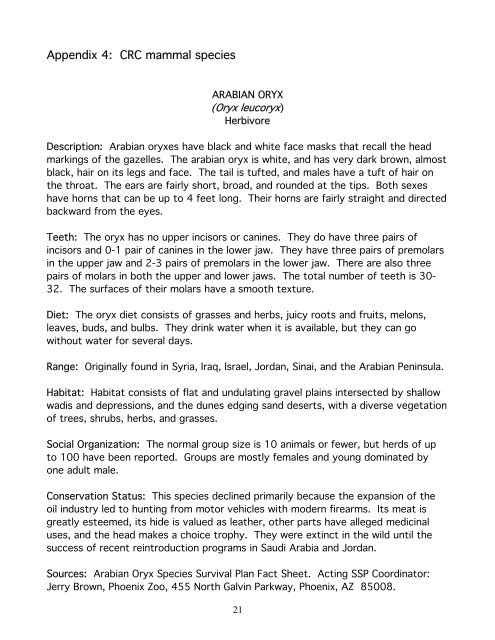TABLE OF CONTENTS - National Zoo
TABLE OF CONTENTS - National Zoo
TABLE OF CONTENTS - National Zoo
You also want an ePaper? Increase the reach of your titles
YUMPU automatically turns print PDFs into web optimized ePapers that Google loves.
Appendix 4: CRC mammal species<br />
ARABIAN ORYX<br />
(Oryx leucoryx)<br />
Herbivore<br />
Description: Arabian oryxes have black and white face masks that recall the head<br />
markings of the gazelles. The arabian oryx is white, and has very dark brown, almost<br />
black, hair on its legs and face. The tail is tufted, and males have a tuft of hair on<br />
the throat. The ears are fairly short, broad, and rounded at the tips. Both sexes<br />
have horns that can be up to 4 feet long. Their horns are fairly straight and directed<br />
backward from the eyes.<br />
Teeth: The oryx has no upper incisors or canines. They do have three pairs of<br />
incisors and 0-1 pair of canines in the lower jaw. They have three pairs of premolars<br />
in the upper jaw and 2-3 pairs of premolars in the lower jaw. There are also three<br />
pairs of molars in both the upper and lower jaws. The total number of teeth is 30-<br />
32. The surfaces of their molars have a smooth texture.<br />
Diet: The oryx diet consists of grasses and herbs, juicy roots and fruits, melons,<br />
leaves, buds, and bulbs. They drink water when it is available, but they can go<br />
without water for several days.<br />
Range: Originally found in Syria, Iraq, Israel, Jordan, Sinai, and the Arabian Peninsula.<br />
Habitat: Habitat consists of flat and undulating gravel plains intersected by shallow<br />
wadis and depressions, and the dunes edging sand deserts, with a diverse vegetation<br />
of trees, shrubs, herbs, and grasses.<br />
Social Organization: The normal group size is 10 animals or fewer, but herds of up<br />
to 100 have been reported. Groups are mostly females and young dominated by<br />
one adult male.<br />
Conservation Status: This species declined primarily because the expansion of the<br />
oil industry led to hunting from motor vehicles with modern firearms. Its meat is<br />
greatly esteemed, its hide is valued as leather, other parts have alleged medicinal<br />
uses, and the head makes a choice trophy. They were extinct in the wild until the<br />
success of recent reintroduction programs in Saudi Arabia and Jordan.<br />
Sources: Arabian Oryx Species Survival Plan Fact Sheet. Acting SSP Coordinator:<br />
Jerry Brown, Phoenix <strong>Zoo</strong>, 455 North Galvin Parkway, Phoenix, AZ 85008.<br />
21
















